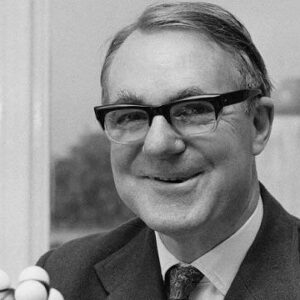Sir John Warcup Cornforth Jr. was an Australian-British chemist who, along with Vladimir Prelog, shared the 1975 Nobel Prize in Chemistry. He won the Nobel Prize in Chemistry for his research on the stereochemistry of enzyme-catalyzed reactions. Cornforth’s life was far from idyllic. He was diagnosed with progressive hearing loss at a young age, a medical condition that eventually rendered him completely deaf. He chose chemistry as his field of study as a result of his hearing loss because it primarily involved conducting reactions and experiments that required visual aid. He was enthralled by the way nature worked and the laws that governed it in daily life. His insatiable curiosity about knowledge and reasoning shaped him into a researcher, and he made significant contributions to science through his profound insight and knowledge. His life was devoted to research in the field of organic chemistry, and his work on stereochemistry was a watershed moment that earned him a Nobel Prize. His accomplishments serve as an inspiration to millions of people worldwide, particularly those living with disabilities, to pursue their dreams with sincere effort. He was a curious and sincere man with an unflinching courage and gratitude for life, which helped him become one of the twentieth century’s most renowned researchers.
Childhood & Adolescence
He was born in Sydney, Australia on September 7, 1917, to John Warcup Cornforth, an Oxford-educated teacher, and Hilda Eipper, a descendant of a German minister who previously worked as a nurse.
He was diagnosed with ostoclerosis, an inner ear disease that causes progressive hearing loss, at the age of ten, and was completely deaf by the age of twenty.
He attended Sydney Boys’ High School, where he met Leonard Basser, a chemistry teacher who inspired and motivated him to conduct chemistry experiments to better understand how various objects in nature work. In 1933, he graduated from high school.
He enrolled at the University of Sydney at the age of 16, where he studied organic chemistry. He earned a Bachelor of Science degree with First Class Honors and the University medal in 1937. He had become completely deaf by this point.
In 1939, he was one of two candidates chosen for a two-year overseas scholarship from the Royal Commission for the Exhibition of 1851. He earned a D.Phil in organic chemistry from Oxford University, England, in 1941, under the supervision of Sir Robert Robinson, an organic chemist and Nobel laureate.
Career of John Cornforth
While pursuing his doctorate in England, World War II broke out, and he and Sir Robert Robinson began working on penicillin. His work focused on determining the structure of penicillin’s central molecule.
Following the war, he joined the Medical Research Council and worked at the National Institute of Medical Research on the synthesis of sterols, including cholesterol. From 1946 to 1962, he worked there for sixteen years.
During his tenure at Medical Council Research, he collaborated with a number of scientists, including George Popjak, on bio-organic chemistry research.
He was also a professor at Warwick University between 1965 and 1971 and at Sussex University between 1971 and 1982. He continued to conduct research until his death.
Significant Works of John Cornforth
He collaborated with George Popjak in the 1960s on the elucidation of the biosynthetic pathway for polyisoprenoids and steroids, which was a significant achievement.
In the field of bio-organic chemistry, he is best known for his work on the stereochemistry of enzyme-catalyzed reactions. He studied enzymes that catalyze changes in organic compounds (substrates) by taking the place of hydrogen atoms in the chains and rings of the substrate. He described the biosynthesis of cholesterol, an exceedingly complex molecule, in detail in his study.
His eminent research on the stereochemical control of the synthesis and biosynthesis of biologically significant molecules is also regarded as one of his seminal contributions to medical science.
Awards and Accomplishments
In 1953, he was elected to the Royal Society and was presented with the Royal Society of Chemistry’s Corday-Morgan Medal.
He shared the 1968 Davy Medal with George Popjak for their outstanding contribution to the field of chemistry.
In 1975, he shared the Nobel Prize in Chemistry with Vladimir Prelog for his work on the stereochemistry of enzyme-catalyzed reactions. In 1975, he was jointly named Australian of the Year with Maj. Gen. Alan Stretton.
In 1976, he was presented with the Royal Medal. In 1977, he was appointed a Knight of the British Empire.
In 1982, the Royal Society awarded him the Copley Medal for his contributions to science.
Personal History and Legacies
He met Rita Harriet Harradence at the University of Sydney, where she was also studying organic chemistry. When she broke a Claisen flask by accident, he repaired it using his glassblowing skills. Following that, he met her at Oxford University in London, where she was the second person to be chosen for the scholarship under Sir Robert Robinson’s supervision.
In 1941, he married Rita and the couple had a son, John, and two daughters, Brenda and Philippa. She was his colleague, science collaborator, co-researcher, and life partner until her death on November 6, 2012, as a result of an illness.
He died in Sussex, England, on December 8, 2013 at the age of 96.
Estimated Net Worth
John Cornforth is one of the wealthiest chemists and is ranked on the list of the most popular chemists. John Cornforth’s net worth is estimated to be around $1.5 million, based on our analysis of Wikipedia, Forbes, and Business Insider.


